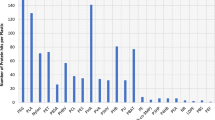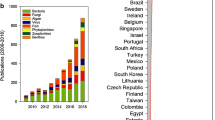Abstract
Petroleum hydrocarbons are among the most important contaminants in aquatic ecosystems, but the effects of different petroleum components on the archaeal communities in these environments are still poorly investigated. Therefore, the effects of representative alkanes, polycyclic aromatic hydrocarbons and crude oil on archaeal communities from marine (Massambaba Beach) and hypersaline waters (Vermelha Lagoon) from the Massambaba Environmental Protection Area, Rio de Janeiro, Brazil, were examined in this study. Hydrocarbon contamination was simulated in vitro, and the resulting microcosms were temporally analyzed (4, 12 and 32 days after contamination) using molecular methods. DNA and RNA extractions were followed by polymerase chain reaction-denaturing gradient gel electrophoresis (PCR-DGGE) analyses and by the further molecular identification of selected DGGE bands. Archaeal communities could not be detected in the marine microcosms after contamination with the different hydrocarbons. In contrast, they were detected by DNA- and RNA-based methods in hypersaline water. Dendrogram analyses of PCR-DGGE showed that the archaeal communities in the hypersaline water-derived microcosms selected for by the addition of heptadecane, naphthalene or crude oil differed from the natural ones observed before the hydrocarbon contaminations. Principal coordinate analysis of the DGGE patterns showed an important effect of incubation time on the archaeal communities. A total of 103 DGGE bands were identified, and phylogenetic analysis showed that 84.4 % and 15.5 % of these sequences were associated with the Euryarchaeota and Crenarchaeota groups, respectively. Most of the sequences obtained were related to uncultivated archaea. Using redundancy analysis, the response of archaeal communities to the type of hydrocarbon contamination used could also be observed in the hypersaline water-derived microcosms.





Similar content being viewed by others
References
Al-Mailem, D. M., Sorkhoh, N. A., Al-Awadhi, H., Eliyas, M., & Radwan, S. S. (2010). Biodegradation of crude oil and pure hydrocarbons by extreme halophilic archaea from hypersaline coasts of the Arabian Gulf. Extremophiles, 14(3), 321–328.
Al-Mailem, D. M., Eliyas, M., & Radwan, S. S. (2012). Enhanced haloarchaeal oil removal in hypersaline environments via organic nitrogen fertilization and illumination. Extremophiles, 16(5), 751–758.
Anderson, R. T., & Lovley, D. R. (2000). Hexadecane decay by methanogenesis. Nature, 404(6779), 722–723.
Andrei, A. Ş., Banciu, H. L., & Oren, A. (2012). Living with salt: metabolic and phylogenetic diversity of archaea inhabiting saline ecosystems. FEMS Microbiology Letters, 330(1), 1–9.
Atlas, R. M., & Hazen, T. C. (2011). Oil biodegradation and bioremediation: a tale of the two worst spills in US history. Environmental Science & Technology, 45, 6709–6715.
Auguet, J. C., Barberan, A., & Casamayor, E. O. (2010). Global ecological patterns in uncultured Archaea. ISME Journal, 4(2), 182–190.
Bano, N., Ruffin, S., Ranson, B., & Hollibaught, J. T. (2004). Phylogenetic composition of arctic ocean archaeal assemblages and comparison with Antarctic assemblages. Applied and Environmental Microbiology, 70, 781–789.
Barbiére, E. B. (1985). Condições climáticas dominantes na porção oriental da lagoa de Araruama (RJ) e suas implicações na diversidade do teor de salinidade. In Caderno de Ciências da Terra (Vol. 59, 35 p). SP, Brazil: Universidade de São Paulo.
Bonfá, M. R., Grossman, M. J., Mellado, E., & Durrant, L. R. (2011). Biodegradation of aromatic hydrocarbons by Haloarchaea and their use for the reduction of the chemical oxygen demand of hypersaline petroleum produced water. Chemosphere, 84(11), 1671–1676.
Chang, W., Um, Y., & Holoman, T. R. (2006). Polycyclic aromatic hydrocarbon (PAH) degradation coupled to methanogenesis. Biotechnology Letters, 28(6), 425–430.
dos Santos, H. F., Cury, J. C., Do Carmo, F. L., Dos Santos, A. L., Tiedje, J., Van Elsas, J. D., et al. (2011). Mangrove bacterial diversity and the impact of oil contamination revealed by pyrosequencing: bacterial proxies for oil pollution. PLoS One, 6(3), e16943. doi:10.1371/journal.pone.0016943.
EPA 8015C. (2000). Nonhalogenated organics using GC/FID. EPA, revision 3, 33p.
Erdoğmuş, S. F., Mutlu, B., Korcan, S. E., Güven, K., & Konuk, M. (2013). Aromatic hydrocarbon degradation by halophilic Archaea isolated from Çamalt Saltern, Turkey. Water Air and Soil Pollution, 224, 1449. doi:10.1007/s11270-013-1449-9.
Ewing, B., & Green, P. (1998). Base-calling of automated sequencer traces using phred: II. Error probabilities. Genome Research, 8, 186–194.
Grant, W. D. (2004). Life at low water activity, review. Philosophical Transactions of the Royal Society Biological Sciences, 359(1448), 1249–1267.
Hardoim, C. C., Costa, R., Araújo, F. V., Hajdu, E., Peixoto, R., Lins, U., et al. (2009). Diversity of bacteria in the marine sponge Aplysina fulva in Brazilian coastal waters. Applied and Environmental Microbiology, 75(10), 3331–3343.
Jurelevicius, D., Korenblum, E., Casella, R., Vital, R. L., & Seldin, L. (2010). Polyphasic analysis of the bacterial community in the rhizosphere and roots of Cyperus rotundus L. grown in a petroleum-contaminated soil. Journal of Microbiology and Biotechnology, 20(5), 862–870.
Jurelevicius, D., Alvarez, V. M., Marques, J. M., Lima, L. R., Dias, F. D., & Seldin, L. (2013). Bacterial community response to petroleum hydrocarbon amendments in freshwater, marine and hypersaline water-containing microcosms. Applied and Environmental Microbiology, 79(19), 5927–5935.
Kim, J. N., Kim, B. S., Kim, S. J., & Cerniglia, C. E. (2012). Effects of crude oil, dispersant, and oil-dispersant mixtures on human fecal microbiota in an in vitro culture system. MBio doi:pii: e00376-12. 10.1128/mBio.00376-12.
Le Borgne, S., Paniagua, D., & Vazquez-Duhalt, R. (2008). Biodegradation of organic pollutants by halophilic Bacteria and Archaea. Journal of Molecular Microbiology and Biotechnology, 15, 74–92.
Margesin, R., & Schinner, F. (2001). Potential of halotolerant and halophilic microorganisms for biotechnology. Extremophiles, 5, 73–83.
McCune, B., & Mefford, M. J. (2011). PC-ORD Multivariate analysis of ecological data, Version 6.0 MjM Software, Gleneden Beach, Oregon, USA.
Pitcher, D. G., Saunders, N. A., & Owen, R. J. (1989). Rapid extraction of bacterial genomic DNA with guanidium thiocyanate. Letters in Applied Microbiology, 8(4), 151–156.
Redmond, M. C., & Valentine, D. L. (2012). Natural gas and temperature structured a microbial community response to the Deepwater Horizon oil spill. Proceedings of the National Academy of Sciences of the United States of America, 109(50), 20292–20297.
Röling, W. F., de Brito Couto, I. R., Swannell, R. P., & Head, I. M. (2004). Response of Archaeal communities in beach sediments to spilled oil and bioremediation. Applied and Environmental Microbiology, 70(5), 2614–2620.
Schloss, P. D., Westcott, S. L., Ryabin, T., Hall, J. R., Hartmann, M., Hollister, E. B., et al. (2009). Introducing mothur: open-source, platform-independent, community-supported software for describing and comparing microbial communities. Applied and Environmental Microbiology, 75, 7537–7541.
Taketani, R. G., Franco, N. O., Rosado, A. S., & van Elsas, J. D. (2010). Microbial community response to a simulated hydrocarbon spill in mangrove sediments. Journal of Microbiology, 48(1), 7–15.
Tapilatu, Y. H., Grossi, V., Acquaviva, M., Militon, C., Bertrand, J. C., & Cuny, P. (2010). Isolation of hydrocarbon-degrading extremely halophilic archaea from an uncontaminated hypersaline pond (Camargue, France). Extremophiles, 14(2), 225–231.
Teske, A., & Sørensen, K. B. (2008). Uncultured archaea in deep marine subsurface sediments: have we caught them all? ISME Journal, 2(1), 3–18.
Valentine, D. L. (2007). Adaptations to energy stress dictate the ecology and evolution of the Archaea. Nature Reviews Microbiology, 5, 316–323.
Wang, Q., Garrity, G. M., Tiedje, J. M., & Cole, J. R. (2007). Naive Bayesian classifier for rapid assignment of rRNA sequences into the new bacterial taxonomy. Applied and Environmental Microbiology, 73, 5261–5267.
Acknowledgments
This study was financially supported through grants from the National Research Council of Brazil (CNPq), Coordenação de Aperfeiçoamento de Pessoal de Nível Superior (CAPES) and Fundação de Amparo à Pesquisa do Estado do Rio de Janeiro (FAPERJ).
Author information
Authors and Affiliations
Corresponding author
Rights and permissions
About this article
Cite this article
Jurelevicius, D., de Almeida Couto, C.R., Alvarez, V.M. et al. Response of the Archaeal Community to Simulated Petroleum Hydrocarbon Contamination in Marine and Hypersaline Ecosystems. Water Air Soil Pollut 225, 1871 (2014). https://doi.org/10.1007/s11270-014-1871-7
Received:
Accepted:
Published:
DOI: https://doi.org/10.1007/s11270-014-1871-7




